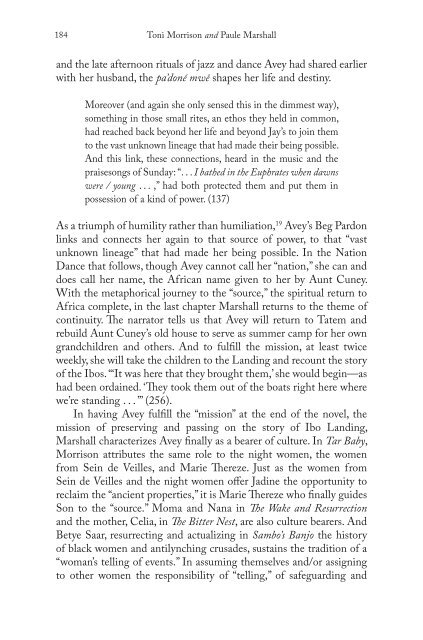Blooms Literary Themes - THE TRICKSTER.pdf - ymerleksi - home
Blooms Literary Themes - THE TRICKSTER.pdf - ymerleksi - home
Blooms Literary Themes - THE TRICKSTER.pdf - ymerleksi - home
Create successful ePaper yourself
Turn your PDF publications into a flip-book with our unique Google optimized e-Paper software.
184<br />
Toni Morrison and Paule Marshall<br />
and the late afternoon rituals of jazz and dance Avey had shared earlier<br />
with her husband, the pa’doné mwê shapes her life and destiny.<br />
Moreover (and again she only sensed this in the dimmest way),<br />
something in those small rites, an ethos they held in common,<br />
had reached back beyond her life and beyond Jay’s to join them<br />
to the vast unknown lineage that had made their being possible.<br />
And this link, these connections, heard in the music and the<br />
praisesongs of Sunday: “. . . I bathed in the Euphrates when dawns<br />
were / young . . . ,” had both protected them and put them in<br />
possession of a kind of power. (137)<br />
As a triumph of humility rather than humiliation, 19 Avey’s Beg Pardon<br />
links and connects her again to that source of power, to that “vast<br />
unknown lineage” that had made her being possible. In the Nation<br />
Dance that follows, though Avey cannot call her “nation,” she can and<br />
does call her name, the African name given to her by Aunt Cuney.<br />
With the metaphorical journey to the “source,” the spiritual return to<br />
Africa complete, in the last chapter Marshall returns to the theme of<br />
continuity. Th e narrator tells us that Avey will return to Tatem and<br />
rebuild Aunt Cuney’s old house to serve as summer camp for her own<br />
grandchildren and others. And to fulfi ll the mission, at least twice<br />
weekly, she will take the children to the Landing and recount the story<br />
of the Ibos. “‘It was here that they brought them,’ she would begin—as<br />
had been ordained. ‘Th ey took them out of the boats right here where<br />
we’re standing . . . ’” (256).<br />
In having Avey fulfi ll the “mission” at the end of the novel, the<br />
mission of preserving and passing on the story of Ibo Landing,<br />
Marshall characterizes Avey fi nally as a bearer of culture. In Tar Baby,<br />
Morrison attributes the same role to the night women, the women<br />
from Sein de Veilles, and Marie Th ereze. Just as the women from<br />
Sein de Veilles and the night women off er Jadine the opportunity to<br />
reclaim the “ancient properties,” it is Marie Th ereze who fi nally guides<br />
Son to the “source.” Moma and Nana in Th e Wake and Resurrection<br />
and the mother, Celia, in Th e Bitter Nest, are also culture bearers. And<br />
Betye Saar, resurrecting and actualizing in Sambo’s Banjo the history<br />
of black women and antilynching crusades, sustains the tradition of a<br />
“woman’s telling of events.” In assuming themselves and/or assigning<br />
to other women the responsibility of “telling,” of safeguarding and

















